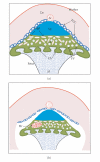PPAR Signaling in Placental Development and Function
- PMID: 18288278
- PMCID: PMC2225458
- DOI: 10.1155/2008/142082
PPAR Signaling in Placental Development and Function
Abstract
With the major attention to the pivotal roles of PPARs in diverse aspects of energy metabolism, the essential functions of PPARgamma and PPARbeta/delta in placental development came as a surprise and were often considered a nuisance en route to their genetic analysis. However, these findings provided an opportune entrée into placental biology. Genetic and pharmacological studies, primarily of knockout animal models and cell culture, uncovered networks of PPARgamma and PPARdelta, their heterodimeric RXR partners, associated transcriptional coactivators, and target genes, that regulate various aspects of placental development and function. These studies furnish both specific information about trophoblasts and the placenta and potential hints about the functions of PPARs in other tissues and cell types. They reveal that the remarkable versatility of PPARs extends beyond the orchestration of metabolism to the regulation of cellular differentiation, tissue development, and trophoblast-specific functions. This information and its implications are the subject of this review.
Figures



References
-
- Ornoy A, Salamon-Arnon J, Ben-Zur Z, Kohn G. Placental findings in spontaneous abortions and stillbirths. Teratology. 1981;24(3):243–252. - PubMed
-
- Krebs C, Macara LM, Leiser R, Bowman AW, Greer IA, Kingdom JCP. Intrauterine growth restriction with absent end-diastolic flow velocity in the umbilical artery is associated with maldevelopment of the placental terminal villous tree. American Journal of Obstetrics and Gynecology. 1996;175(6):1534–1542. - PubMed
-
- Cross JC. How to make a placenta: mechanisms of trophoblast cell differentiation in mice—a review. Placenta. 2005;26:S3–S9. - PubMed
-
- Simmons DG, Cross JC. Determinants of trophoblast lineage and cell subtype specification in the mouse placenta. Developmental Biology. 2005;284(1):12–24. - PubMed
Grants and funding
LinkOut - more resources
Full Text Sources
Research Materials

